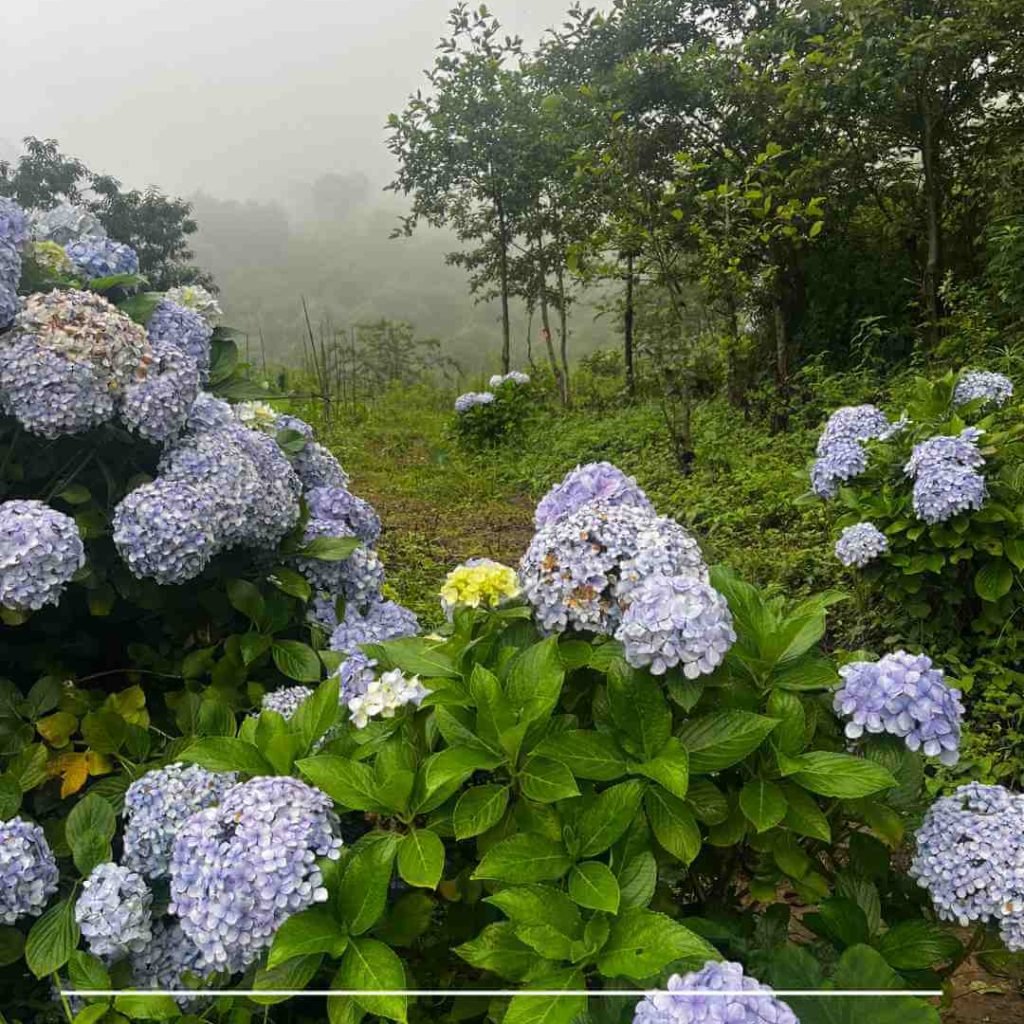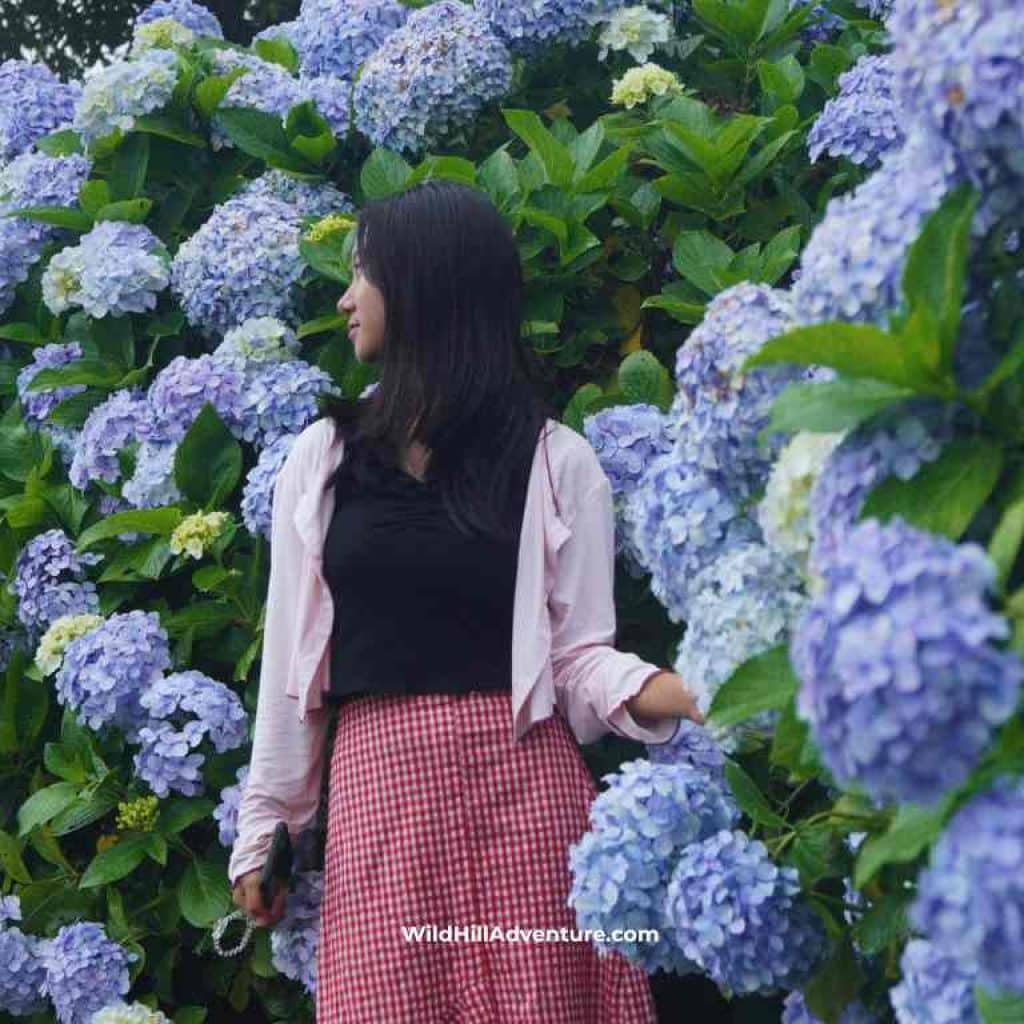Hydrangea Flower Garden in Kigwema Nagaland
Nagaland, the “Land of Festivals,” is a jewel in Northeast India, often surprising travelers with its pristine natural beauty and vibrant cultural tapestry. While many are familiar with its tribal heritage and war history, fewer know about the breathtaking floral wonders hidden within its rolling hills. One such marvel is the Akiile Potato Farm, Kigwema, more popularly known as the Hydrangea Flower Garden & Rhododendron Trail. Join us on an unforgettable journey to this floral paradise, nestled amidst the serene landscapes of Nagaland.
Your Gateway to Nagaland: Reaching Kigwema
Planning a trip to this enchanting garden requires a bit of foresight, especially when it comes to travel and permits. Here’s how you can embark on your adventure:
- By Flight: The nearest airport is Dimapur Airport (DMU). From there, you can hire a taxi or take a shared sumo to Kohima.
- By Train: The closest railway station is Dimapur Railway Station (DMAP). Similar to the airport, you’ll find plenty of transportation options from Dimapur to Kohima.
- Dimapur to Kohima: The journey from Dimapur to Kohima covers approximately 80 km and usually takes about 2-3 hours, depending on traffic conditions. The road winds through scenic landscapes, offering glimpses of rural Naga life.
- Kohima to Kigwema: Once in Kohima, Kigwema is about 20 km away and takes roughly 1 hour to reach. This leg of the journey is equally picturesque, taking you deeper into the Naga hills.
Important Note on Permits (ILP): For non-Naga visitors, an Inner Line Permit (ILP) is mandatory to enter Nagaland. You can conveniently apply for your ILP online. Ensure you have this sorted before your travel dates to avoid any last-minute hassles.

The Journey Begins: From Kohima to Floral Bliss
Hydrangea Flower Garden in Kigwema Nagaland
Our adventure to the Hydrangea Garden began in Kohima, refreshed after exploring the cultural richness of Dzuleke and Khonoma Village (Asia’s first green village). The anticipation was palpable as we set out:
From Kohima, it takes approximately an hour to reach the Jakhama TCP Gate. This is a crucial stop where you’ll need to verify your government ID (like an Aadhar card). Since the Hydrangea Garden is located within an area that requires passing through an army camp, this ID verification is mandatory. Once your ID is submitted and cleared, your journey truly begins!
Just about 10 minutes from the TCP gate, we arrived at our starting point for the trek. This is where the real excitement began! We were fortunate to meet some friendly Konyak locals (a prominent tribe in Nagaland) who were also heading in the same direction. What started as a casual encounter quickly blossomed into a shared journey filled with laughter and camaraderie. Traveling to such hidden gems often leads to spontaneous friendships, and this was a perfect example.
The Rhododendron Trail and Beyond
After a delightful trek of about 30 minutes with our new friends, we reached the entry point of the garden.
- Entry Fee: The entry fee is a modest ₹20 per person.
- Amenities: To our pleasant surprise, there’s a small shop at the entrance offering a range of refreshments – tea, coffee, cold drinks, snacks, and even Maggie noodles. What truly impressed us, especially given its remote and high-altitude location, was the impeccable cleanliness of the washrooms. They were meticulously maintained and hygienic, a testament to the care taken by the people looking after this beautiful place. The entire area surrounding the garden was remarkably clean, a detail we truly appreciated.
This location is also renowned as the Rhododendron Trail. If you visit during the rhododendron season, you’ll be greeted by an explosion of vibrant hues, as countless rhododendron bushes adorn the landscape. The garden’s official name, Akiile Potato Farm, Kigwema (Hydrangea Garden & Rhododendron Trail), truly reflects its dual botanical treasures.
During our hike, we were treated to stunning panoramic views of Kohima city, nestled serenely amidst the hills. It was a breathtaking sight, a reminder of the beauty that surrounds you in Nagaland.
A Spectacle of Hydrangeas and Spontaneous Joy
And then, we arrived. The Hydrangea Flower Garden in Kigwema, Nagaland. My eyes could barely believe the sight. A vast expanse of vibrant hydrangeas, in every shade of blue, pink, and purple, unfolded before us like a living tapestry. It was a truly awe-inspiring moment, reinforcing the belief that Nagaland is an absolute gem for nature lovers. The sheer beauty of the place left us speechless.
We spent a considerable amount of time capturing the magic – countless photos and reels with our new Konyak friends. The joy of the moment was infectious. What followed was an unexpected and delightful surprise: our newfound companions invited us to join their picnic! They had packed an incredible spread – noodles, Maggie, pasta, cold drinks, coffee, chicken, and so much more. It was nothing short of a grand party, spontaneously organized amidst the beauty of the garden. These are the moments that truly define travel – forging connections with strangers who quickly become good friends, sharing food and laughter in an idyllic setting.

After indulging in the delicious feast and soaking in every last bit of the garden’s serenity, it was time to bid farewell to this remarkable place.
Best Time to Visit: Witnessing the Blooms in Their Full Glory
To truly experience the Hydrangea Flower Garden in all its splendor, timing is key.
- Best Season:
- Hydrangeas: While hydrangeas can start blooming as early as May, the peak season for hydrangeas at Akiile Potato Farm is generally from June to July. During these months, the garden is a riot of vibrant blues, purples, and pinks, transforming the landscape into a painter’s palette. The post-monsoon freshness also adds to the allure, as the flowers appear even more vibrant after the rain.
- Rhododendrons: The garden is also known as a Rhododendron Trail. Rhododendrons typically bloom in Nagaland from late February to April, with peak flowering often observed in March. If your primary interest is the rhododendrons, an earlier spring visit would be ideal.
- Overall Pleasant Weather: For a comfortable trekking and sightseeing experience with clear skies and mild temperatures, October to April is generally considered a pleasant time to visit Kigwema and Nagaland in general. However, if seeing the hydrangeas in full bloom is your priority, then June and July are the months to aim for, even if it means a bit of monsoon showers.
- Best Time of Day:
- Morning (around 8:00 AM – 11:00 AM): This is arguably the best time to visit. The morning light is soft and diffused, perfect for photography, and the air is fresh and cool, making the trek more enjoyable. You’ll likely encounter fewer crowds, allowing for a more peaceful experience. Hydrangeas, in general, thrive with morning sun and prefer to avoid the harsh afternoon heat, which can cause them to wilt.
- Late Afternoon (around 3:00 PM – 5:00 PM): Another excellent time, especially if you want to catch the golden hour light for stunning photographs. As the sun begins to set, the colors of the flowers can take on a beautiful glow. The heat of the day subsides, making the return trek comfortable. However, ensure you have enough daylight for your hike back, especially since a portion of the journey involves passing through the army camp area.
Beyond the Hydrangeas: Nearby Attractions
The Hydrangea Flower Garden in Kigwema is perfectly situated to explore some of Nagaland’s other iconic destinations:
- Dzukou Valley Trek: A legendary trek known for its breathtaking rolling hills, seasonal flowers (especially the Dzukou Lily), and pristine natural beauty. It’s a must-do for any avid trekker visiting Nagaland.
- Khonoma Village: Asia’s first green village, renowned for its sustainable practices, rich Angami tribal culture, and historical significance.
- Dzuleke Village: A charming village offering a glimpse into rural Naga life, surrounded by lush greenery and serene landscapes.
- Jakhama Village: A significant village known for its historical importance and proximity to Kohima.
- Kohima City: The capital of Nagaland, offering war memorials, local markets, and a vibrant urban experience.
A visit to the Hydrangea Flower Garden in Kigwema is more than just a trip to a garden; it’s an immersive experience that combines the thrill of discovery, the beauty of nature, and the warmth of human connection. If you’re seeking an off-the-beaten-path adventure filled with floral wonders and unforgettable memories, Nagaland’s Hydrangea Garden should undoubtedly be on your travel list. Start planning your journey to this hidden paradise today!
Contact Wild Hill Adventure Directly! For any Northeast India Tour or Southeast Asia Tours
- Call or WhatsApp (24×7 Available): +91 93654 76611 | +91 70020 47509
- Email: wildhilladventure@gmail.com
- Instagram: https://www.instagram.com/wildhilladventure/
- YouTube: https://www.youtube.com/@northeastnoshad
Frequently Asked Questions (FAQs)
What is the best time to see the Hydrangea flowers in full bloom?
The peak season for Hydrangea blooms at Akiile Potato Farm in Kigwema is generally from June to July. This is when the garden is most vibrant with these beautiful flowers.
Can I see Rhododendrons at this garden too?
Yes, the garden is also known as the Rhododendron Trail. Rhododendrons typically bloom earlier, from late February to April, with peak flowering often in March. If you wish to see both, a visit in late May or early June might offer a glimpse of both fading rhododendrons and emerging hydrangeas, but for peak blooms, you’ll need to choose your season.
Is an Inner Line Permit (ILP) required to visit Nagaland?
Yes, an Inner Line Permit (ILP) is mandatory for non-Naga Indian citizens to enter Nagaland. Foreign nationals require a Protected Area Permit (PAP). You can apply for the ILP online.
How far is Kigwema from Kohima, and how long does it take to reach?
Kigwema is approximately 20 km from Kohima and takes about 1 hour to reach by road.
Is there an entry fee for the Hydrangea Flower Garden?
Yes, there is a nominal entry fee of ₹20 per person.
Are there any facilities available at the garden?
Yes, there’s a small shop at the entry point offering tea, coffee, cold drinks, snacks, and Maggie. Impressively, clean and hygienic washrooms are also available.
Is the trek to the garden difficult?
The trek is relatively short, about 30 minutes, and generally considered easy to moderate. It involves walking through scenic trails.
Do I need to carry any identification for entry?
Yes, you will need to verify a government ID like an Aadhar card at the Jakhama TCP Gate, as the garden is accessed through an area near an army camp.
What other attractions are near the Hydrangea Flower Garden in Kigwema?
Nearby attractions include Dzukou Valley (for trekking), Khonoma Village (Asia’s first green village), Dzuleke Village, Jakhama Village, and Kohima City itself.
What is the best time of day to visit the garden?
Morning (8:00 AM – 11:00 AM) is ideal for soft light and fewer crowds. Late afternoon (3:00 PM – 5:00 PM) offers beautiful golden hour light, but ensure you have enough daylight for your return.








0 Comment